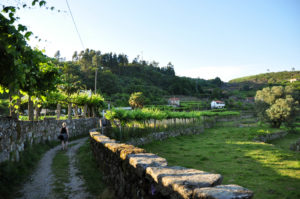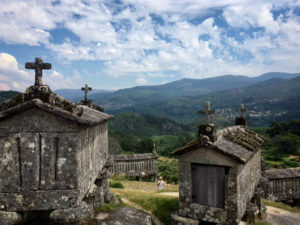By Katie Allie
These are my stories from the road and hard-won guidance from a thoughtful traveler. If I’m making you curious about getting lost and finding the good stuff in this great big world we all share, then I’m doing something right.
Porto was a change from the cleaned-up, black and white facades of Lisbon. She was a bit rough around the edges, colored in between the lines with bright pockets of graffiti and steep hills that jump into her riverbanks. Her people were different too—more cigarettes jostling in mouths, hustling visitors more openly as the tourist season was officially kicking off. I found myself admiring Porto’s eccentricities while playing the role of tour guide, showing my friend around a part of Portugal that most people never see: the north.
I spent a year living in Portugal and quickly came to realize that most people only ever see this country on a quick side trip to Lisbon when they hop over from Spain. Very few make it to Porto, while others will head south to the beaches of the Algarve, but otherwise I was amazed at just how few people even knew where Portugal was on a map. For shame! Northern Portugal in particular is still a sleepy, hushed-up, wine lover’s daydream. The Douro region, famed for its red wine and port and forgotten villages, barely even makes a blip on most travelers’ radars. I wanted to see why there wasn’t more of a fuss.
 After forking over a meager €12 for a round-trip train ticket from Lisbon to Porto, my friend and I rented a car, and soon we were zooming east. As city gave way to farmland and then to vineyards, we stopped so we could take in the carefully etched terraces of grapevines eked out in neat little lines and old stone walls standing behind bright red poppies. More than once we got lost on winding country roads, only to find ourselves sputtered out in cobblestoned villages—who knows where—with locals peeking sideways out of butcher shops to smile at us. Within two hours, it was like we’d gone back in time 200 years.
After forking over a meager €12 for a round-trip train ticket from Lisbon to Porto, my friend and I rented a car, and soon we were zooming east. As city gave way to farmland and then to vineyards, we stopped so we could take in the carefully etched terraces of grapevines eked out in neat little lines and old stone walls standing behind bright red poppies. More than once we got lost on winding country roads, only to find ourselves sputtered out in cobblestoned villages—who knows where—with locals peeking sideways out of butcher shops to smile at us. Within two hours, it was like we’d gone back in time 200 years.
Our first stop was Pinhão, where the road dead-ends and most visitors arrive on a day trip by boat. At midday, the mercury was stretched well past 100 degrees, with the only souls in sight being alley cats soaking in pockets of shade. Sweat ran down our necks as we wrestled into bathing suits. A local had told us about a swimming hole in the vaguest of terms, and we were just heat crazed enough to seek out its cool, black waters.
A couple of hours at the swimming hole, a sunburned shower and a few port tonics later, and we were good to go. That night we dove into plates of grilled fish, garlicky olives, local wine and moonlit river walks. Everyone had returned to Porto on the day-tripper boat. So far, Northern Portugal wasn’t disappointing us.
The next day, we pressed on to the Peneda-Gerês National Park, where we rented the town baker’s old stone house in Soajo, bordered by a field of horses and the faint remnants of hiking trails. Even fewer tourists venture here, concealed as it is in the mountains near the Spanish border. The town itself is at least 500 years old, though it is believed to have been inhabited much earlier than that.
Many homes are built around enormous boulders, making for a unique pre-dinner walk. The streets that wound through the village were foot traffic only and had a stone trough running alongside them to carry water through and cool things down. Here and there, locals had small household vineyards or a cow in their yard. Nuns in their habits carefully made their way through uneven streets while small dogs escorted us around, nervously sniffing in our path. It was the golden hour, and the smell of grilled chouriço was filling the air, so we retired to dinner until it was time to sneak away to the edge of town by starlight and visit the espigueiros that overlook the valley below. Espigueiros are open-air granaries, commonly lifted up on stone stilts to keep out rats. They draw attention because they look unnervingly like above-ground coffins, particularly with the cross that adorns them in order to bless the grain contained within. We sat between them, legs crisscrossed, eyes up, mouths open wide to the galaxy slowly turning over our heads. At this point, I was having a hard time keeping track of all the magical moments I’d experienced on this trip.
Because few people travel here, I thought playing tour guide in Northern Portugal would be hard work—that I would have to work to find interesting things to see or the people would be rude. The truth is, though, between the smiling faces, natural beauty and superb eating and drinking, it was too easy. By the time we arrived back in Porto, I was as relaxed as I was the day I spent floating on my back in Pinhão’s secret swimming hole or drinking local wine while climbing through a tangle of unusual granaries on a country hillside. Portugal, it turns out, is an easy country to enjoy.
Author’s Note
I barely do Northern Portugal justice here. There is a lifetime more to see and experience, with a rich cultural tradition that is still very much intact. Portugal really puts on a show for Easter, but if you find yourself there during the intense summer heat, here are directions to Pinhão’s secret, locals-only swimming hole:
Backtrack out of town to the small bridge—remember the road dead-ends here, so if you came by car, it’s the bridge by which you entered—and continue walking. Say hi to the locals as you go, but don’t get too distracted, as you’ll need to take the first right off the road onto a gravel path. You will pass by private homes and vineyards, and you will probably think I’ve led you astray. After about 10 minutes of walking, you will find yourself parallel to the banks of the river. It will become obvious when you’ve arrived at the swimming hole, as it is a publicly maintained area with a wide section for swimming. The path down is steep, but it’s worth it. There is a natural waterslide that I also suggest you take advantage of. After you cool off, stop in the coffee shop/bar exactly opposite the train station in town for a port tonic. They’ll give you excellent advice regarding dinner, and if you play your cards right, they can also set you up with local olive oil, wine and cheese producers in the area. Enjoy!
 About the Author
About the Author
Katie Allie is a West Virginia native who holds degrees in English and elementary education. A teacher by trade, she spent years in a classroom before branching out as a travel consultant and writer. With five continents under her belt and an affinity for noodle soup, it should come as no surprise that she loves to write about food and talk adventure. She may be reached at hello@acrossthelinetravel.com.



